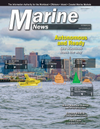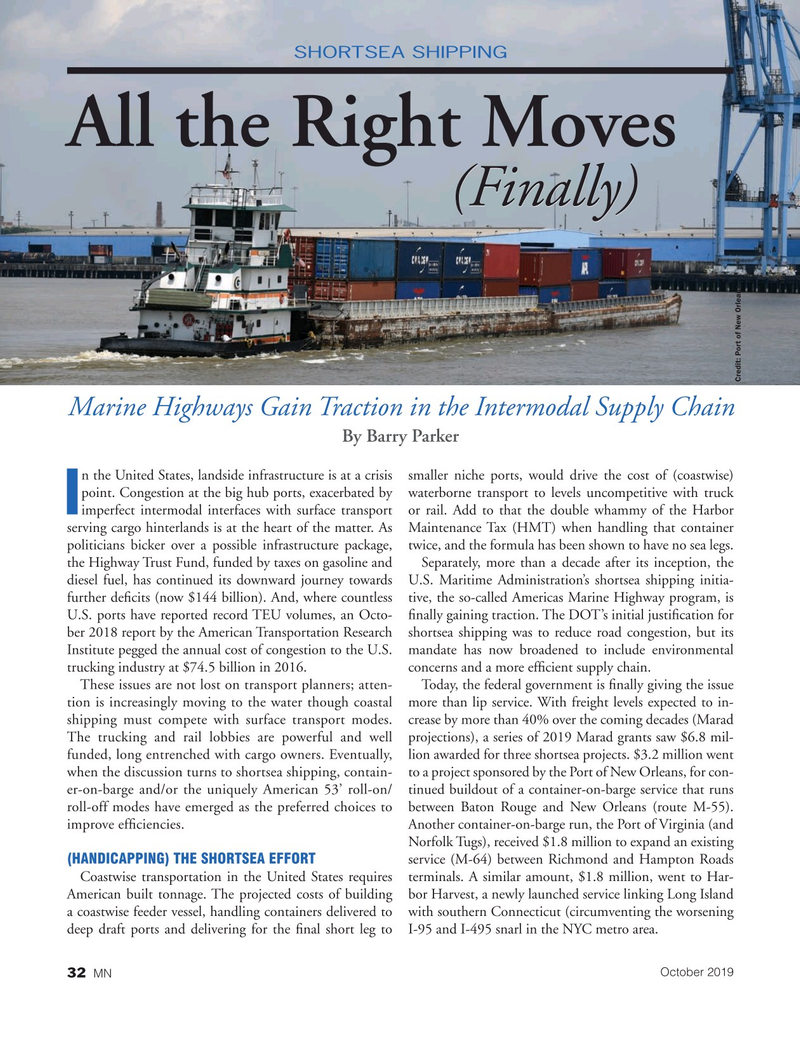
Page 32: of Marine News Magazine (October 2019)
Autonomous Workboats
Read this page in Pdf, Flash or Html5 edition of October 2019 Marine News Magazine
SHORTSEA SHIPPING
All the Right Moves (Finally) (Finally)
Credit: Port of New Orleans
Marine Highways Gain Traction in the Intermodal Supply Chain
By Barry Parker n the United States, landside infrastructure is at a crisis smaller niche ports, would drive the cost of (coastwise) point. Congestion at the big hub ports, exacerbated by waterborne transport to levels uncompetitive with truck imperfect intermodal interfaces with surface transport or rail. Add to that the double whammy of the Harbor
I serving cargo hinterlands is at the heart of the matter. As Maintenance Tax (HMT) when handling that container politicians bicker over a possible infrastructure package, twice, and the formula has been shown to have no sea legs.
the Highway Trust Fund, funded by taxes on gasoline and Separately, more than a decade after its inception, the diesel fuel, has continued its downward journey towards U.S. Maritime Administration’s shortsea shipping initia- further de? cits (now $144 billion). And, where countless tive, the so-called Americas Marine Highway program, is
U.S. ports have reported record TEU volumes, an Octo- ? nally gaining traction. The DOT’s initial justi? cation for ber 2018 report by the American Transportation Research shortsea shipping was to reduce road congestion, but its
Institute pegged the annual cost of congestion to the U.S. mandate has now broadened to include environmental trucking industry at $74.5 billion in 2016. concerns and a more ef? cient supply chain.
These issues are not lost on transport planners; atten- Today, the federal government is ? nally giving the issue tion is increasingly moving to the water though coastal more than lip service. With freight levels expected to in- shipping must compete with surface transport modes. crease by more than 40% over the coming decades (Marad
The trucking and rail lobbies are powerful and well projections), a series of 2019 Marad grants saw $6.8 mil- funded, long entrenched with cargo owners. Eventually, lion awarded for three shortsea projects. $3.2 million went when the discussion turns to shortsea shipping, contain- to a project sponsored by the Port of New Orleans, for con- er-on-barge and/or the uniquely American 53’ roll-on/ tinued buildout of a container-on-barge service that runs roll-off modes have emerged as the preferred choices to between Baton Rouge and New Orleans (route M-55). improve ef? ciencies. Another container-on-barge run, the Port of Virginia (and
Norfolk Tugs), received $1.8 million to expand an existing (HANDICAPPING) THE SHORTSEA EFFORT service (M-64) between Richmond and Hampton Roads
Coastwise transportation in the United States requires terminals. A similar amount, $1.8 million, went to Har-
American built tonnage. The projected costs of building bor Harvest, a newly launched service linking Long Island a coastwise feeder vessel, handling containers delivered to with southern Connecticut (circumventing the worsening deep draft ports and delivering for the ? nal short leg to I-95 and I-495 snarl in the NYC metro area.
October 2019 32 MN

 31
31

 33
33
